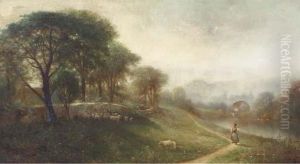J. C. Macgregor Paintings
J. C. Macgregor, also known as John Charles Macgregor, was a notable figure in the early 20th-century Scottish art scene. Born in 1883, Macgregor's career spanned a period of significant change and innovation in European art, witnessing the rise of modernism and the shifting dynamics of art movements such as Impressionism, Post-Impressionism, and the early stages of Expressionism. Despite these tumultuous changes, Macgregor remained somewhat of an enigmatic figure, often blending traditional techniques with emerging styles, thus creating a unique oeuvre that was both reflective of his time and distinctly personal.
Throughout his life, Macgregor was deeply influenced by the rugged landscapes of Scotland, as well as the burgeoning artistic movements that were emerging across Europe. He trained at the prestigious Glasgow School of Art, where he was exposed to a variety of artistic philosophies and techniques. His early work was characterized by a strong adherence to realism, with a particular focus on the Scottish landscape and its myriad of natural features. However, as his career progressed, Macgregor began experimenting with more abstract forms and vibrant color palettes, indicative of the influence of Post-Impressionism and early Expressionism.
Macgregor's contributions to the Scottish art world were significant, though he often shied away from the limelight, preferring the solitude of his studio to the bustling art scenes of Glasgow and Edinburgh. Despite this, his works were exhibited in various galleries across Scotland and England, receiving acclaim for their emotional depth and technical proficiency. Macgregor was also a dedicated educator, teaching at his alma mater, the Glasgow School of Art, where he influenced a new generation of Scottish artists.
J. C. Macgregor's legacy is one of quiet innovation. He managed to navigate the changing tides of early 20th-century art, leaving behind a body of work that is both a testament to the traditions of Scottish painting and an exploration of new artistic expressions. His death in 1947 marked the end of a career that, while not as publicly celebrated as some of his contemporaries, contributed significantly to the landscape of Scottish art. Today, Macgregor's works are considered important pieces of the early modernist movement in Scotland, celebrated for their unique blend of tradition and innovation.
